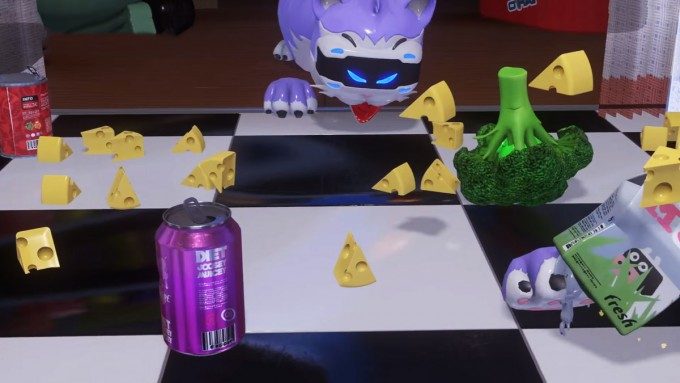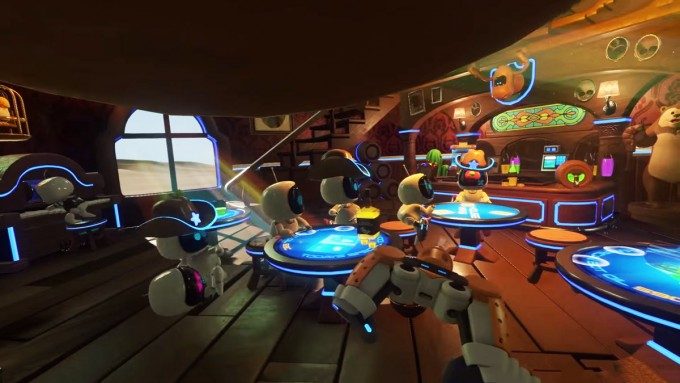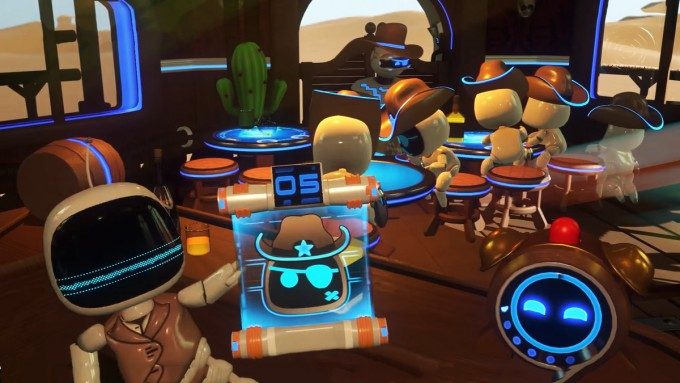One of the most fun parts about virtual reality is still watching friends and family experience it. PlayStation VR’s The Playroom VR takes this one step further by making VR inclusive for a whole couch full of friends.
With just one PlayStation VR headset, The Playroom VR makes for fun with up to five players thanks to its roster of competitive and cooperative party games. I recently got to put my head in The Playroom VR and was impressed with the creative game design, which leverages the fact that one player is immersed in VR with the headset on while the others are on the couch. Sometimes all five players are working together, sometimes the player wearing the PSVR is pitting against those on the couch, and sometimes the players on the couch don’t even need a controller to participate. I came away feeling like this sort of local+social content hits a unique sweet spot for VR fun, and it’s something we could use a lot more of in the VR space.
Cat N Mouse
In the ‘Cat N Mouse’ game, the player wearing the PSVR headset takes the form of a cat while the non-VR players, wielding controllers, play as mice.
The cat hides behind a series of curtains while the mice run around on the kitchen floor with the goal of collecting cheese. If the cat pops their head through the curtains while the mice are in plain sight, they’ll get caught and knocked out of the round. There’s various kitchen items spread across the floor which offer a safe haven for the mice to hide behind.
The tension of not knowing when the cat will pop out from behind the curtain is anxiety-inducing, and both sites attempt juke one another throughout the match. If the mice manage to collect all of the cheese, the cat loses. For the cat to win it has to catch all of the mice.
Saloon Shootout
The Saloon Shootout (not the official name for this mini-game) is a cooperative game which can actually be played with as many non-VR players as you’d like (as they don’t need a controller to participate).
The player wearing the PSVR headset finds themselves as a sheriff confronting a room full of potential bandits with varying facial features. The player has to select which among them is the real bandit to shoot, but the only way they can know is through a description from the other players. The non-VR players are shown a picture of the bandit and must describe the details to the PSVR-wearing player accurately, otherwise they risk harming an innocent bystander.
The characters in the scene can look quite alike; there’s a time limit so you need to work fast, but if the sheriff jumps the gun before the full description is given (or if the description isn’t specific enough), they’ll end up with a face full of lead rubber darts.
Ghost House
‘Ghost House’ is another cooperative/description game which can have more than five players since those on the couch don’t need to use a controller. The player wearing the PSVR headset enters a dark, haunted room sprinkled with furniture and other objects. A PSVR controller in the PSVR player’s hands acts as a flashlight and a paranormal vacuum with which to capture ghosts. But there’s just one problem… the ghosts are completely invisible.

Only the non-VR players can see the ghosts that need to be captured, and they need to tell the VR player exactly where they are located so that the VR player can point their controller at the ghost and vacuum it up. The ghosts move regularly and are fairly small, so the non-VR players need to be quite specific in order to be successful.
Once a ghost’s location is identified, the PSVR-wearing player fires their capture device and initially tethers the ghost, but at this point the ghost won’t go down easy. The ghost flies around the room fighting to escape the tether, and the player has to keep their controller pointed at the ghost for several seconds to prevent it from escaping.
Monster Escape
Monster Escape is a VR vs. non-VR game where the player wearing PSVR is a giant monster barreling down a long city street chasing four non-VR players who are all wielding controllers.

The non-VR players are running down the street away from the monster and must jump over obstacles on the road while also dodging debris launched by the monster. The monster launches these objects by smashing its head into buildings and nearby helicopters to try to hit the non-VR players.
If the non-VR players make it to the end of the road, it becomes their turn to go on the offensive. At this stage the non-VR players pick up objects scattered about and throw them at the monster’s head. The PSVR player has to duck and weave in order to avoid getting hit. Too many hits and the non-VR players will collectively blast the monster back into space, (presumably) from whence it came.
The Playroom VR isn’t the only VR game which makes active participants out of willing observers (Keep Talking and Nobody Explodes is another excellent example), but it is an excellent starting point for VR Party Gaming, which we hope to see much more of in the future!









